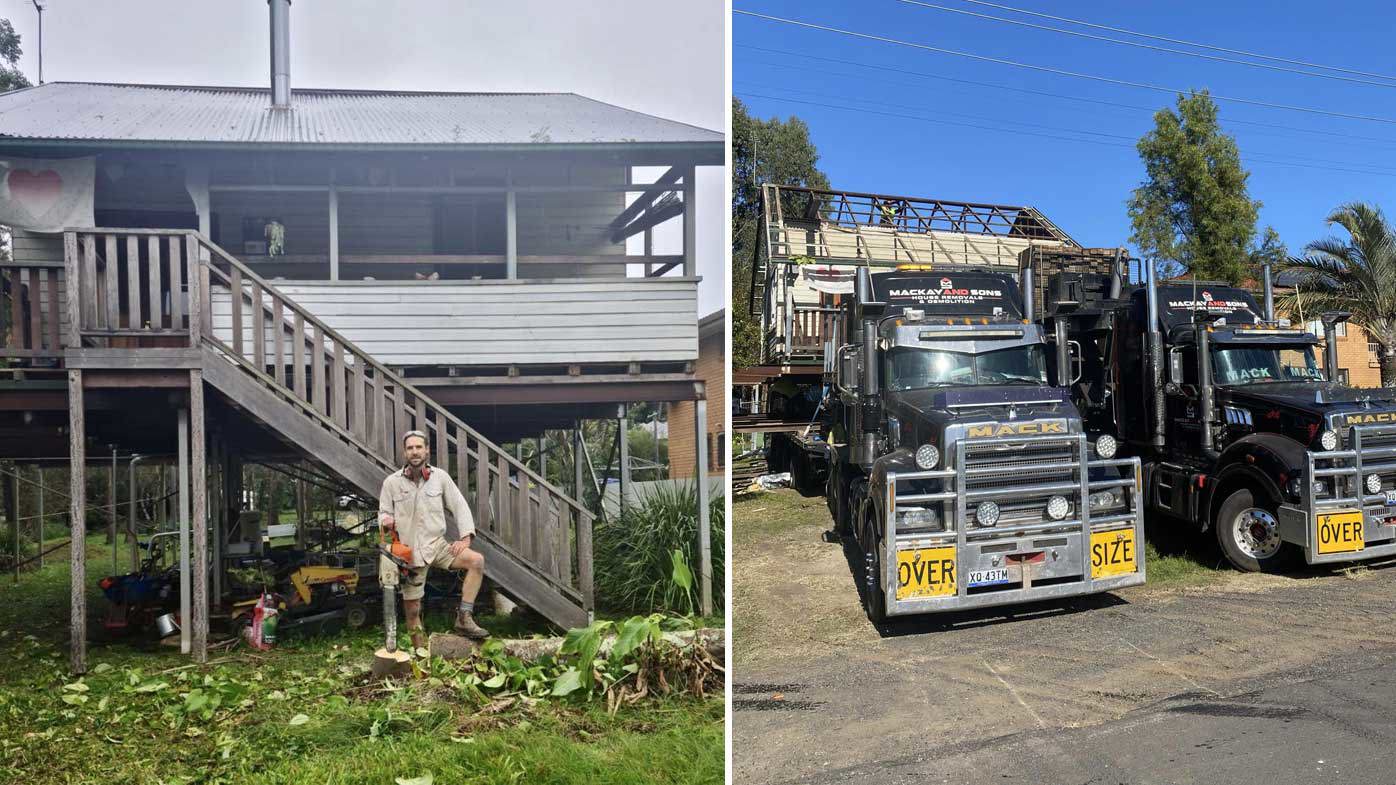
It was midnight when the trucks rolled down Terania Street, Lismore, in the Northern Rivers region of New South Wales and loaded up Hamish Webster’s 110-year-old, two-bedroom worker’s cottage.
The historic house had been chopped in two, to comply with the local road load width restrictions.
“It was definitely nerve-racking to watch them cut my house in half; the house that I had just spent a lot of blood, sweat and tears putting back together after the floods,” Webster said.
READ MORE: Four dead, nine hurt in shooting at US high school, authorities say
But the relocation of the timber cottage, in late June, went smoothly.
Around 45 minutes later, the house was set down 30 kilometres away in its new location, a housing development site in Nimbin.
Two-and-a-half years on from the catastrophic floods of February 2022, Webster is one of about seven Lismore homeowners to date who have managed to preserve their homes by relocating them outside of the floodplain.
The relocations have been made possible by the $700 million Resilient Homes program, which gives eligible flood victims the option to sell their land back to the government and take their home with them to a new property.
Having spent his teenage years in Lismore, Webster bought the rundown cottage in December 2020 for $250,000, thinking of it as a project he could sink his teeth into.
READ MORE: Emotional parents open up on slain sons’ $500,000 legacy
By August 2021 he had spent a lot of money raising the house above the one-in-100-year flood level.
But it wasn’t high enough. Six months later, the devastating floods wreaked their havoc, with the water level reaching 1.7m above that record flood level.
Webster’s flood-damaged house was not insured.
“Immediately after the floods, I had no idea what was going on. I didn’t have insurance so I just went into ‘fix my house’ mode,” he said.
After 10 months of back-breaking work, Webster was able to move back in last year.
“I finished renovating it, and turned it into a beautiful home,” Webster said.
“I was really, really proud of all the work that I had done, I had put so much effort into it, I was fully trauma-bonded with the house.
“The thought of just walking away from it, to leave it to some uncertain future, I just couldn’t bear it. So I was keen on the idea of relocating it.”
READ MORE: Teen driver flung from car, hit by vehicle stopping to help
However, the road to get his house to Nimbin had not been easy, Webster said.
Initially, the rules of the buyback scheme did not allow people to live in their property post buyback, while they completed the purchase of new land and arranged their relocation.
Webster successfully lobbied the government to have this rule overturned.
“It just so happened for my case, I had the buyback money come through and my land settlement and my license to occupy post settlement all came through on the exact same day. So it was very stressful,” he said.
Webster received $380,000 for the buyback of his land. While the cost to relocate his home was about $100,000, the final price often varied depending on the size of the home and distance to the new location, he said.
READ MORE: Senator ‘needs to nail Higgins’ lie’, trial told
Rescuing a part of Lismore’s history, especially a cottage such as his made from old growth timber, had been well worth the struggle, Webster said.
“I’ve got a background in furniture making, so I’m really passionate about timber,” he said.
“All of that timber is from original, untouched, virgin forests that was cut to make these homes, and that’s just really special.”
‘A huge sense of relief’
In July, the Kilburn family moved their 100-year-old Lismore home 14.5km north to Modanville.
Like Webster’s home, the Kilburns’ house was also transported by truck at midnight.
“We were lucky that our house was quite narrow, so we got special approval to move it in one piece without it being cut,” mother-of-two Jo Kilburn said.
It was a nerve racking and agonisingly slow journey under police escort which took four hours, she added.
“Of course, no-one realised it was bin night. So they had to stop all the way along the road and move bins backwards and forwards.”
READ MORE: ‘Person of interest’ in 2002 cruise ship death avoids jail for assault
The Kilburns had been living in their historic timber Lismore home for 20 years before it was inundated in the 2022 floods.
“It is special to us. (My husband and I) were married the year after we bought the house, and both our boys were brought home as bubs,” Kilburn said.
After receiving an insurance payout, the Kilburns spent about seven months renovating the house, before finding out they were eligible for a buyback.
Despite it costing them $140,000 to relocate their home, the move was far cheaper than building a new house and also allowed the keep their house which was filled with memories, Kilburn said.
READ MORE: ‘Dead men don’t talk’ – but one mother is making her son’s voice heard
It was also reassuring to be located away from the floodplain, she said.
“It’s just a huge sense of relief having the house here and knowing that we won’t ever have to go through that again,” she said.
However it did feel very strange to be moving around the same with a different view outside, Kilburn added.
“In (Lismore) we had a neighbour on one side and a service station on the other side,” she said.
“Now we’re looking out the windows at a beautiful view of the valley – it’s bizarre”.
READ MORE: Man allegedly lured police to his Melbourne home before stabbing constable
About 5000 homes were flooded in the 2022 Lismore floods. As of March this year, 700 people across the Northern Rivers had received a buyback offer, The Sydney Morning Herald reported.
In 2026, 400 blocks of land in Lismore will be initially opened to flood victims who have received a land buyback.
Harper Dalton is a local house relocation advocate who runs the Facebook group Relocate Lismore Homes.
“Why I created the group is that we don’t want to just demolish these old, beautiful, historical homes,” he said.
“We really should be preserving them and relocating them instead of demolishing them and replacing them with new builds of plantation timber, which is not going to have anywhere near the character and the same quality as the current housing stock.”
Dalton said he was hopeful the red tape surrounding relocating homes could continue to be cut, however, it was important to realise that relocating a house could be a difficult process.
“You don’t click your fingers and it happens overnight. Even with the house relocation companies, because it’s such a specialised area and there’s not very many of these companies doing it, they’re looking at between a four-to-six month wait as well.
“There are things that will take some time, but it’s still a really positive move to see these beautiful old homes being relocated.”
links to content on ABC
9News





